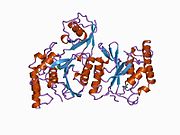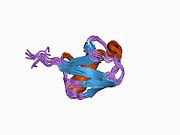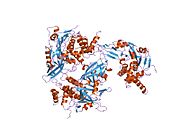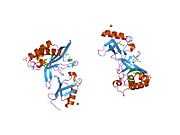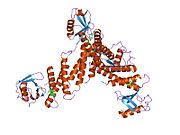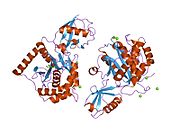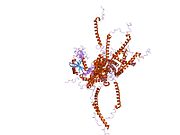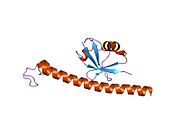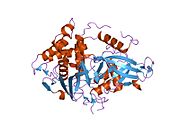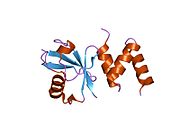60S ribosomal protein L40 (RPL40) is a protein that in humans is encoded by the UBA52 gene.
Function
Ubiquitin is a highly conserved nuclear and cytoplasmic protein that has a major role in targeting cellular proteins for degradation by the 26S proteosome. It is also involved in the maintenance of chromatin structure, the regulation of gene expression, and the stress response. Ubiquitin is synthesized as a precursor protein consisting of either polyubiquitin chains or a single ubiquitin moiety fused to an unrelated protein. This gene encodes a fusion protein consisting of ubiquitin at the N-terminus and ribosomal protein L40 at the C-terminus, a C-terminal extension protein (CEP). Multiple processed pseudogenes derived from this gene are present in the genome.
References
- ^ GRCh38: Ensembl release 89: ENSG00000221983 – Ensembl, May 2017
- "Human PubMed Reference:". National Center for Biotechnology Information, U.S. National Library of Medicine.
- "Mouse PubMed Reference:". National Center for Biotechnology Information, U.S. National Library of Medicine.
- Webb GC, Baker RT, Coggan M, Board PG (Jun 1994). "Localization of the human UBA52 ubiquitin fusion gene to chromosome band 19p13.1-p12". Genomics. 19 (3): 567–9. doi:10.1006/geno.1994.1108. PMID 8188300.
- ^ "Entrez Gene: UBA52 ubiquitin A-52 residue ribosomal protein fusion product 1".
Further reading
- Wool IG, Chan YL, Glück A (1996). "Structure and evolution of mammalian ribosomal proteins". Biochem. Cell Biol. 73 (11–12): 933–47. doi:10.1139/o95-101. PMID 8722009.
- Murphey RK, Godenschwege TA (2002). "New roles for ubiquitin in the assembly and function of neuronal circuits". Neuron. 36 (1): 5–8. doi:10.1016/S0896-6273(02)00943-1. PMID 12367500. S2CID 15764136.
- Baker RT, Board PG (1992). "The human ubiquitin/52-residue ribosomal protein fusion gene subfamily (UbA52) is composed primarily of processed pseudogenes". Genomics. 14 (2): 520–2. doi:10.1016/S0888-7543(05)80258-7. PMID 1330885.
- Baker RT, Board PG (1991). "The human ubiquitin-52 amino acid fusion protein gene shares several structural features with mammalian ribosomal protein genes". Nucleic Acids Res. 19 (5): 1035–40. doi:10.1093/nar/19.5.1035. PMC 333777. PMID 1850507.
- Monia BP, Ecker DJ, Jonnalagadda S, et al. (1989). "Gene synthesis, expression, and processing of human ubiquitin carboxyl extension proteins". J. Biol. Chem. 264 (7): 4093–103. doi:10.1016/S0021-9258(19)84967-0. PMID 2537304.
- Lund PK, Moats-Staats BM, Simmons JG, et al. (1985). "Nucleotide sequence analysis of a cDNA encoding human ubiquitin reveals that ubiquitin is synthesized as a precursor". J. Biol. Chem. 260 (12): 7609–13. doi:10.1016/S0021-9258(17)39652-7. PMID 2581967.
- Salvesen G, Lloyd C, Farley D (1987). "cDNA encoding a human homolog of yeast ubiquitin 1". Nucleic Acids Res. 15 (13): 5485. doi:10.1093/nar/15.13.5485. PMC 305980. PMID 3037496.
- Cross SH, Charlton JA, Nan X, Bird AP (1994). "Purification of CpG islands using a methylated DNA binding column". Nat. Genet. 6 (3): 236–44. doi:10.1038/ng0394-236. PMID 8012384. S2CID 12847618.
- Cook WJ, Jeffrey LC, Kasperek E, Pickart CM (1994). "Structure of tetraubiquitin shows how multiubiquitin chains can be formed". J. Mol. Biol. 236 (2): 601–9. doi:10.1006/jmbi.1994.1169. PMID 8107144.
- Vadlamudi RK, Joung I, Strominger JL, Shin J (1996). "p62, a phosphotyrosine-independent ligand of the SH2 domain of p56lck, belongs to a new class of ubiquitin-binding proteins". J. Biol. Chem. 271 (34): 20235–7. doi:10.1074/jbc.271.34.20235. PMID 8702753.
- Bonaldo MF, Lennon G, Soares MB (1997). "Normalization and subtraction: two approaches to facilitate gene discovery". Genome Res. 6 (9): 791–806. doi:10.1101/gr.6.9.791. PMID 8889548.
- Kenmochi N, Kawaguchi T, Rozen S, et al. (1998). "A map of 75 human ribosomal protein genes". Genome Res. 8 (5): 509–23. doi:10.1101/gr.8.5.509. PMID 9582194.
- Cruz C, Ventura F, Bartrons R, Rosa JL (2001). "HERC3 binding to and regulation by ubiquitin". FEBS Lett. 488 (1–2): 74–80. doi:10.1016/S0014-5793(00)02371-1. PMID 11163799. S2CID 20091003.
- Lee TA, Tyers M (2002). "Ubiquitin junction, what's your function?". Genome Biol. 2 (10): REPORTS4025. doi:10.1186/gb-2001-2-10-reports4025. PMC 138970. PMID 11597332.
- Yoshihama M, Uechi T, Asakawa S, et al. (2002). "The human ribosomal protein genes: sequencing and comparative analysis of 73 genes". Genome Res. 12 (3): 379–90. doi:10.1101/gr.214202. PMC 155282. PMID 11875025.
- Bishop N, Horman A, Woodman P (2002). "Mammalian class E vps proteins recognize ubiquitin and act in the removal of endosomal protein-ubiquitin conjugates". J. Cell Biol. 157 (1): 91–101. doi:10.1083/jcb.200112080. PMC 2173266. PMID 11916981.
- Strausberg RL, Feingold EA, Grouse LH, et al. (2003). "Generation and initial analysis of more than 15,000 full-length human and mouse cDNA sequences". Proc. Natl. Acad. Sci. U.S.A. 99 (26): 16899–903. Bibcode:2002PNAS...9916899M. doi:10.1073/pnas.242603899. PMC 139241. PMID 12477932.
| PDB gallery | |
|---|---|
|
This article on a gene on human chromosome 19 is a stub. You can help Misplaced Pages by expanding it. |





